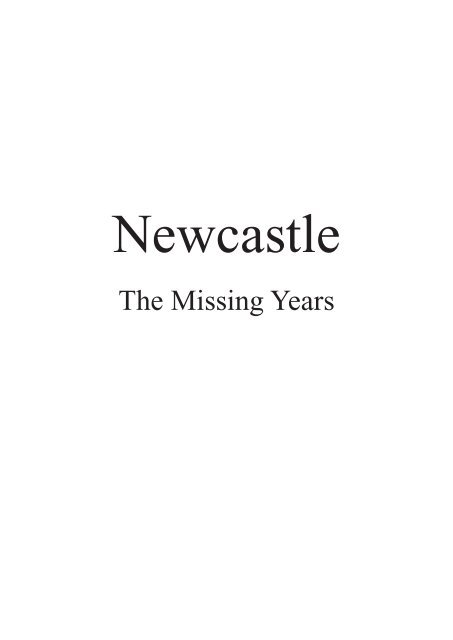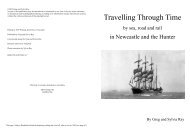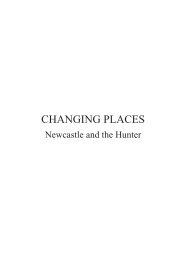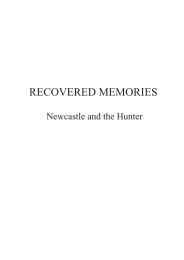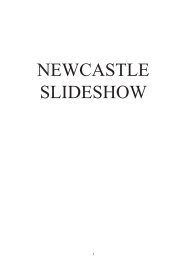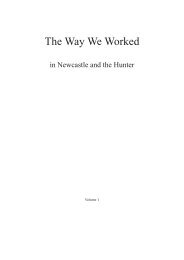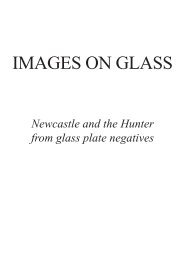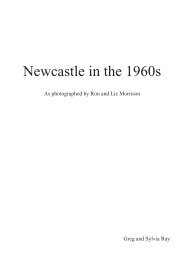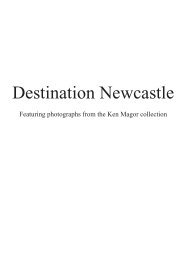Pages from Newcastle Missing Years 8th print 2016
You also want an ePaper? Increase the reach of your titles
YUMPU automatically turns print PDFs into web optimized ePapers that Google loves.
<strong>Newcastle</strong><br />
The <strong>Missing</strong> <strong>Years</strong>
©2010 Greg and Sylvia Ray<br />
No part of this publication may be reproduced or transmitted in any form or by any means electronic<br />
or mechanical, and including photocopying, recording or by information storage and retrieval systems,<br />
without the written permission of the copyright owner.<br />
Eighth <strong>print</strong>ing, <strong>2016</strong><br />
Printed by NCP Printing, Steel River, <strong>Newcastle</strong><br />
Published by Greg and Sylvia Ray<br />
Concept and design by Greg and Sylvia Ray<br />
Research and captions by Greg Ray<br />
Special thanks to:<br />
Barry Magor, Roger Brock, Ross Melville, Julie Ainsworth, Ron and Liz Morrison, Chris Watson,<br />
Carol Edmonds.<br />
Front cover photo:<br />
An intriguing telephoto view of Hunter Street. This photo was probably taken <strong>from</strong> an upstairs window<br />
of Tyrrell House, <strong>Newcastle</strong> East. The telephoto lens has compressed the scene, which extends <strong>from</strong><br />
the old Westminster Hotel to Darks Ice and Cold Storage works and to the hills beyond. The photo was<br />
taken at the time of <strong>Newcastle</strong>’s 150th anniversary celebrations in 1947.<br />
Title page vignette:<br />
Looking east along Hunter Street, <strong>Newcastle</strong>, on June 3, 1939.<br />
2
NEWCASTLE<br />
The <strong>Missing</strong> <strong>Years</strong><br />
Photographs of <strong>Newcastle</strong> and the Hunter in the 1930s and 1940s<br />
Selected, arranged and interpreted by Greg Ray<br />
Layout and image restoration by Sylvia Ray<br />
3
Introduction<br />
In June 2010 I bought a collection of old glass and film negatives. I bought the photos, largely sight<br />
unseen, on the expectation that many of the images were likely to be of the Hunter Region. From a brief<br />
pre-auction inspection I could see the pictures dated <strong>from</strong> the 1880s to the 1950s.<br />
The previous owner was a transport historian and enthusiast, the late Ken Magor, items <strong>from</strong> whose<br />
extensive collections – I later learned – have found their way into museums around Australia.<br />
I began to examine the collection and was amazed to discover what amounted to a real treasure trove<br />
of pictures of <strong>Newcastle</strong> and the Hunter, chiefly concentrated on the years between 1934 and 1949. As<br />
I scanned the negatives and studied the pictures it dawned on me that some of the photographs were<br />
of such high quality they could only have been taken by professionals. Closer examination persuaded<br />
me that many of them were actually taken by press photographers, almost certainly employees of The<br />
<strong>Newcastle</strong> Morning Herald and The <strong>Newcastle</strong> Sun.<br />
Former Sun photographer Ron Morrison, who started work as a cadet at the paper in 1949, recalled<br />
working alongside such able colleagues as Milton Merrilees, Cec Piggott, Tom Hall and Archie Miller.<br />
Inspecting some of these photos, Mr Morrison noted that they reflected the widely varying philosophies<br />
and techniques of news photographers at the time.<br />
Some of the pictures, for example, were highly posed, while others simply recorded events in a more<br />
candid style. Mr Morrison recalled many workplace debates about these competing approaches. In his<br />
opinion, the work of the “recorders” has in many cases better stood the test of time, especially because<br />
the backgrounds in the photos have, over the years, taken on an unanticipated value.<br />
Mr Morrison said many of the pictures were almost certainly not the work of staff photographers.<br />
The liberal use of filters in some shots, he believed, suggested they were produced by contributors <strong>from</strong><br />
among the city’s studio photographers, some of whom did regular freelance work.<br />
The pictures – whoever their creators might be – reveal a <strong>Newcastle</strong> that is both familiar and alien:<br />
the <strong>Newcastle</strong> of my grandparents’ lifetimes. They show the city moving out of the Great Depression,<br />
a little down at heel, but still full of pride, life and grandeur. They show a city stripped for war, with<br />
air-raid shelters on the streets, tank traps on the beaches and warships in the harbour.<br />
In many ways, the hard-bitten <strong>Newcastle</strong> revealed here may seem, paradoxically, a more confident<br />
and self-reliant city than the one we know today.<br />
The late Ken Magor, fireman and<br />
transport enthusiast, photographed for<br />
a <strong>Newcastle</strong> Herald article in 1984.<br />
Mr Magor collected and preserved the<br />
photographs that appear in this book.<br />
4
A 1950s picture, by <strong>Newcastle</strong> press photographer Ron Morrison, of his work colleagues. From left<br />
to right: Arch Miller (Herald), Movietone cameraman John Leake, Milton Merrilees (Sun), Tom<br />
Hall (Herald) and Cec Piggott (Sun). These photographers are probably responsible for creating<br />
many of the images published in this book. Picture reproduced by kind courtesy of Mr Morrison.<br />
The more I studied these photographs the more I became convinced that they deserved to be shared in<br />
book form. The <strong>Newcastle</strong> of the nineteenth and early twentieth centuries has been celebrated in a number<br />
of excellent pictorial volumes, and the city of the 1960s and 1970s has also been ably depicted in more<br />
than one volume of photographs. But it seemed to me that, in some respects, the years these rediscovered<br />
photographs cover had been “missing years”. This was largely because, during the Depression and war<br />
years, photography was too expensive, equipment and supplies too scarce, and most people too preoccupied<br />
with more pressing concerns than taking pictures.<br />
Scanning the negatives has been like an archaeological dig, with each pass of the scanner bringing<br />
some new piece of knowledge or insight into my city as it was then and, consequently, as it is today.<br />
I feel a great delight and sense of privilege to have managed, by a stroke of good luck, to have kept<br />
these images where they belong and I am grateful for the chance to preserve them. I know many readers<br />
will share my excitement at glimpsing these “missing years”. I am sure that Novocastrians will find them<br />
informative, entertaining and even moving.<br />
The feeling of jubilation, for example, in the photographs of Victory Day celebrations in August 1945<br />
is tangible, as is the sombre, skin-prickling sensation in the pictures of wounded men being taken <strong>from</strong> a<br />
torpedo-damaged ship in <strong>Newcastle</strong> Harbour in 1942.<br />
It is always true that most people don’t consider the potential historic value of items <strong>from</strong> just a decade<br />
or even two before their own lifetimes. That was certainly the case during the 1950s and 1960s when these<br />
images – and many, many more – were lost <strong>from</strong> newspaper archives around Australia.<br />
I feel a debt of gratitude to the late Mr Magor, whose enthusiasm and urge to collect and record has<br />
made it possible for these endangered memories of <strong>Newcastle</strong>’s missing years to be returned to us.<br />
I am grateful too, to my wife Sylvia for her painstaking efforts in restoring some of the images, laying<br />
out and designing this book, and to the <strong>Newcastle</strong> Herald for supporting its publication.<br />
5<br />
Greg Ray
A city with its sleeves rolled up<br />
One of the most interesting books I own is a 1937 <strong>Newcastle</strong> electoral roll. I like this lumpy old<br />
book for the glimpse it gives of our city several decades ago. It tells a thousand stories (all of them<br />
obviously short) about a time long gone.<br />
You can tell what a different town it was by looking at the occupations. In Carrington there were<br />
labourers, coal trimmers and seamen by the score, along with the occasional intriguing entry like that<br />
of Owen Garrigan, special constable, of the Criterion Hotel in Bourke Street.<br />
Adamstown was largely populated by labourers, miners and tradesmen. Hamilton and Lambton<br />
were a little more genteel, with a few more clerks, radio technicians, horse trainers and teachers<br />
seasoning the blue-collar population. At 19 Cleary Street lived Moses Phillips, musician. In the same<br />
house was Mozart Phillips, “no occupation”.<br />
In Mayfield ironworkers rubbed shoulders with blacksmiths, motor drivers, crane examiners and<br />
slaughtermen. In Fawcett Street my eyes fell on the Mawkes household where two separate men named<br />
Nathaniel worked at butter making and wire-drawing, respectively.<br />
In Merewether lived upholsterers, tailors, grocers, police sergeants, analytical chemists, machinists,<br />
lorry drivers and dental surgeons. Sherlock Holmes lived in Henry Street; he was an icemaker.<br />
<strong>Newcastle</strong> was similarly diverse, with milliners, accountants and master bakers. John Allen lived in<br />
Darby Street and listed his occupation as “independent means”. Brant Addison lived at the Exchange<br />
Hotel; he was a third mate.<br />
Women in <strong>Newcastle</strong> in 1937 were overwhelmingly occupied by “home duties”, though some were<br />
“typistes” or “telephonists”. Of course there were plenty of nurses (many living at the nurses’ home),<br />
teachers, waitresses, stenographers, dressmakers, saleswomen and manageresses. Lilian Bowden, of<br />
Bruce Street, was a “retoucher”.<br />
The lost livelihoods fascinate – the coppersmith, the plate-layer, the furnaceman, the pattern-maker,<br />
the greaser, the coach-builder: all reflections of a sleeves-rolled-up city humming with industries and<br />
activities long departed.<br />
There’s no doubt at all that life was harder then. The air was full of smoke <strong>from</strong> the steelworks and<br />
other heavy industries. Medical care was primitive and social welfare was scanty. Thousands of men<br />
worked at hard, dangerous jobs on the hectic waterfront, at the mighty BHP and its allies, in the city’s<br />
abattoir, on the busy tramways, at the rail shops and scores of small enterprises.<br />
The <strong>Newcastle</strong> reflected in the pages of this single plotless book is a purposeful one, sure of its place<br />
in the world. It’s hard to avoid comparisons to the post-industrial city of today. The steelworks is gone,<br />
along with almost all its heavy industrial sisters. The port is still busy, of course, but it does most of its<br />
heavy lifting by machine these days. The ships’ crews are small and foreign. More and more jobs are<br />
part-time or casual. “Home duties” is not such a predominant occupation for women.<br />
Blue collars are outnumbered by white and both are probably outnumbered by T-shirts.<br />
Left: A portion of a page <strong>from</strong> the<br />
1937 <strong>Newcastle</strong> electoral roll.<br />
6
A holiday crowd alights <strong>from</strong> a full train at the platform of <strong>Newcastle</strong> Railway Station, December 27, 1937.<br />
7
Crowd at <strong>Newcastle</strong> waterfront 1934. The <strong>print</strong> is taken <strong>from</strong> a glass negative. The occasion is not known.<br />
8
A typical big crowd of railway travellers on the platform at <strong>Newcastle</strong> Station in the late 1930s or early 1940s.<br />
9
View of <strong>Newcastle</strong> East <strong>from</strong> <strong>Newcastle</strong> Hospital, October 1935, with a smoky Zaara Street power station.<br />
10
Looking west along Scott Street <strong>from</strong> the footpath near <strong>Newcastle</strong> Railway Station on February 15, 1936.<br />
The “Richmond Beer” sign is on the side of the Centennial Hotel, which extended through to Hunter Street.<br />
11
An aerial view of <strong>Newcastle</strong>’s newly forming Civic precinct in the mid-1930s, before Nesca House was built.<br />
12


